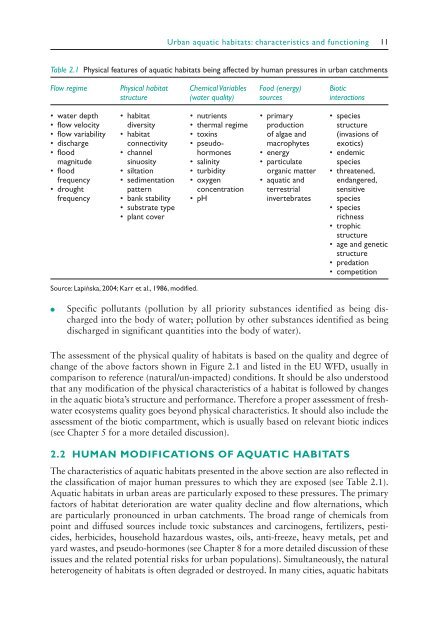Aquatic Habitats In Sustainable Urban Water Management
Aquatic Habitats In Sustainable Urban Water Management
Aquatic Habitats In Sustainable Urban Water Management
- No tags were found...
Create successful ePaper yourself
Turn your PDF publications into a flip-book with our unique Google optimized e-Paper software.
<strong>Urban</strong> aquatic habitats: characteristics and functioning 11<br />
Table 2.1 Physical features of aquatic habitats being affected by human pressures in urban catchments<br />
Flow regime Physical habitat Chemical Variables Food (energy) Biotic<br />
structure (water quality) sources interactions<br />
• water depth<br />
• flow velocity<br />
• flow variability<br />
• discharge<br />
• flood<br />
magnitude<br />
• flood<br />
frequency<br />
• drought<br />
frequency<br />
• habitat<br />
diversity<br />
• habitat<br />
connectivity<br />
• channel<br />
sinuosity<br />
• siltation<br />
• sedimentation<br />
pattern<br />
• bank stability<br />
• substrate type<br />
• plant cover<br />
• nutrients<br />
• thermal regime<br />
• toxins<br />
• pseudohormones<br />
• salinity<br />
• turbidity<br />
• oxygen<br />
concentration<br />
•pH<br />
• primary<br />
production<br />
of algae and<br />
macrophytes<br />
• energy<br />
• particulate<br />
organic matter<br />
• aquatic and<br />
terrestrial<br />
invertebrates<br />
• species<br />
structure<br />
(invasions of<br />
exotics)<br />
• endemic<br />
species<br />
• threatened,<br />
endangered,<br />
sensitive<br />
species<br />
• species<br />
richness<br />
• trophic<br />
structure<br />
• age and genetic<br />
structure<br />
• predation<br />
• competition<br />
Source: Lapiǹska, 2004; Karr et al., 1986, modified.<br />
●<br />
Specific pollutants (pollution by all priority substances identified as being discharged<br />
into the body of water; pollution by other substances identified as being<br />
discharged in significant quantities into the body of water).<br />
The assessment of the physical quality of habitats is based on the quality and degree of<br />
change of the above factors shown in Figure 2.1 and listed in the EU WFD, usually in<br />
comparison to reference (natural/un-impacted) conditions. It should be also understood<br />
that any modification of the physical characteristics of a habitat is followed by changes<br />
in the aquatic biota’s structure and performance. Therefore a proper assessment of freshwater<br />
ecosystems quality goes beyond physical characteristics. It should also include the<br />
assessment of the biotic compartment, which is usually based on relevant biotic indices<br />
(see Chapter 5 for a more detailed discussion).<br />
2.2 HUMAN MODIFICATIONS OF AQUATIC HABITATS<br />
The characteristics of aquatic habitats presented in the above section are also reflected in<br />
the classification of major human pressures to which they are exposed (see Table 2.1).<br />
<strong>Aquatic</strong> habitats in urban areas are particularly exposed to these pressures. The primary<br />
factors of habitat deterioration are water quality decline and flow alternations, which<br />
are particularly pronounced in urban catchments. The broad range of chemicals from<br />
point and diffused sources include toxic substances and carcinogens, fertilizers, pesticides,<br />
herbicides, household hazardous wastes, oils, anti-freeze, heavy metals, pet and<br />
yard wastes, and pseudo-hormones (see Chapter 8 for a more detailed discussion of these<br />
issues and the related potential risks for urban populations). Simultaneously, the natural<br />
heterogeneity of habitats is often degraded or destroyed. <strong>In</strong> many cities, aquatic habitats















